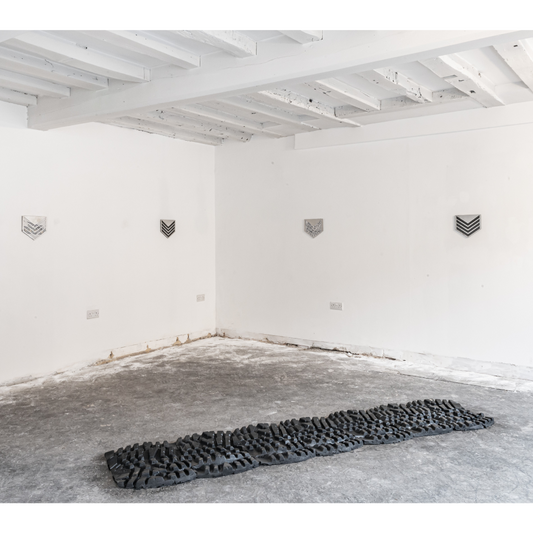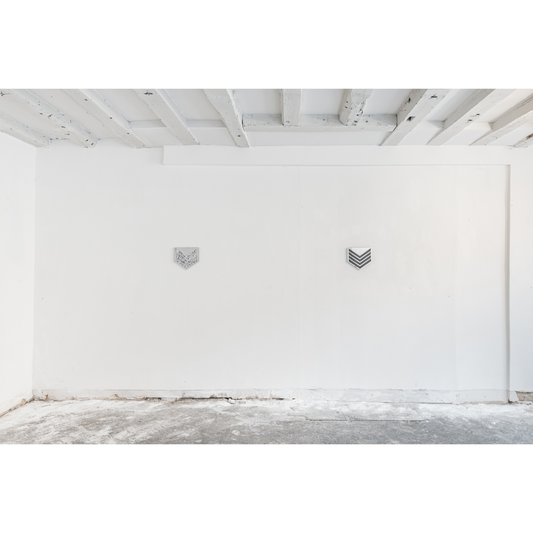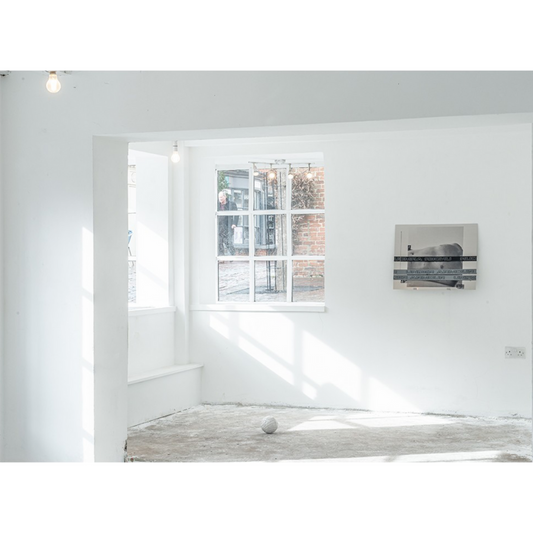Theo Papandreopoulos
Echo's Bones (I)
Lion & Lamb Gallery (March 2023)
Farnham, United Kingdom
PART 1
*15-minute study
In Part I/II of this survey of Theo Papandreopoulos's exhibition Echo's Bones, Sunend examines his deconstruction of seemingly banal objects critically engaging with the complex relationship between masculinity and structures of power. This part focuses on his works Dragon Skin (2023) and Untitled (2023)--wall pieces which incorporate military epaulettes--and introduces his curatorial distinction between ‘main’ and ‘supporting’ works by looking at the installation dispersed throughout the gallery. Papandreopoulos re-engineers objects associated with authority and hierarchy through absurd juxtapositions and amplification of specific elements, evoking both menace and vulnerability while revealing the tension of the deviant eroticism embedded within authoritarian standardised uniformity.
Key references and methodology: In Part I of Sunend's survey of Echo's Bones, the deconstruction of objects is framed through the lens of military masculinity, drawing on Paul R. Higate’s (2003) analysis of rank and hierarchy as central psychological structures in both military and civilian contexts. Papandreopoulos’s works, including Dragon Skin (2023) and Untitled (2023) military epaulette pieces, exemplify the complex interplay between authority and masculinity, as highlighted by his manipulation of scale, form, and weight—a concept discussed in Dawn Ades’s (1996) essay in Hayward Gallery’s “Art and Power.” His re-engineered objects create a tension akin to the "mythic allure" of Francis Bacon’s transformations, as noted by David Sylvester (2000). Rachel Woodward’s (2003) insights into military identity formation inform our understanding of Papandreopoulos’s interrogation of masculinity's boundaries, drawing parallels with Klaus Theweleit’s (1977) concept of the split between the male exterior and female interior. Papandreopoulos’s exposé of the eroticism embedded within authoritarian forms, pushing them into uncanny, unsettling realms, parallels with Tim Benton’s (1996) critique of authoritarian aesthetics. And the eroticism as individual expression as witnessed in Marquis de Sade’s 120 Days of Sodom is described by Jane Gallop (1981). And the tension between individual expression and collective power, as articulated by David Elliot (1996) in “The Battle for Art,” helps to frame Papandreopoulos’s exploration of the contradictions inherent in constructing idealised masculinity. Finally, Com Toibin (2015) essay on Francis Bacon’s late paintings’ “Spirit and Substance” helps us introduce Papandreopoulos’s installation which like his practice is influenced by Samuel Beckett’s absurdism conveyed by paring key elements down to a minimum.
In Part II, the survey will further examine these themes through sculpture works made from testosterone powder, and assemblages incorporating stickers and Nazi uniform trousers. These pieces investigate the role of physical fitness, politics and religion within military systems and their broader influence on mainstream society, informed by Papandreopoulos's experiences growing up in the Greek Orthodox faith and serving in the Hellenic Army.
 Echo’s Bones gallery exhibition view from outside Lion & Lamb Art Space
Echo’s Bones gallery exhibition view from outside Lion & Lamb Art Space
Sunend is pleased to present a survey of Theo Papandreopoulos’s exhibition Echo’s Bones. Papandreopoulos investigates the multivalent intersecting ways the measurement of the physical size and rank play an integral psychological role within both military and civilian life (Higate, 2003). This is done through objects traditionally associated with authority, hierarchy, and power. He employs a heterogeneous array of mediums in his research-based practice, including embroidery, metalwork, 3D printing, the incorporation of genuine military insignia, and even bodybuilding supplements such as creatine and testosterone powder.
A new epoch is moulded not by literary men but by warriors.
- Adolf Hitler, 1937
The exhibition title, Echo's Bones, draws from a 1933 short story by Samuel Beckett. While thematically unrelated to the military, the title's inherent semantic dissonance mirrors the conceptual fissures elucidated by Papandreopoulos within his works. Echo's Bones provides the overarching framework for the exhibition, which itself can be interpreted as a staged exploration of the historical conflict between power and the artistic representation of masculinity (Hobsbawm, 1996), facilitated by works that possess a distinctly Dadaesque aesthetic with their “disjunction of scale,” form, and weight that deliberately “fail to resolve” themselves by manipulating the aesthetics of power’s “binding and controlling impulses” (Ades, 1996).

First room of the gallery, from left to right on the walls all Untitled (2023), £1,200 each, and in the foreground, Dragon Skin (2023), £2500
In a meticulously curated space mirroring the rigorous “order, cleanliness, and hygiene” (Woodward, 2003) characteristic of military establishments, Papandreopoulos now based in London following his Master’s at the Royal College of Art deconstructs gendered objects traditionally associated with power, employing a strategy that is both conceptually intricate and aesthetically fraught. This manifests through the deliberate re-engineering of the objects' original purpose, form, and semantics. Papandreopoulos' work is demonstrably shaped by two key influences: his upbringing within the Greek Orthodox Christian faith and his obligatory national military service. During his conscription, his talents were identified, and he was tasked with creating art to inspire his fellow infantry soldiers, which ironically reinforced his critical engagement.

Francis Bacon, Jet of Water, oil and dry transfer lettering on canvas, 1979.
Courtesy Studies in Digital Heritage.
Similar to Francis Bacon's practice, Papandreopoulos utilises autobiographical elements within his work. However, his chosen medium is the transformation of objects – specifically those signifying male power – into entities imbued with a "mythic allure and weight" (Sylvester, 2000). His work is grounded in an adaptation of the source objects’ physical and semantic properties to achieve a distinct level of abstraction, which can be likened to the absurdist narrative structures employed by Samuel Beckett.
The exhibition itself, encompassing both the works and the meticulously curated atmosphere, functions as a unified whole, conveying Papandreopoulos’s "chilling vision of threat and alienation" (Calvocoressi, 2015) as it pertains to the construct of masculinity. This vision investigates and confronts the aspects of the conflict experienced by contemporary men, caught between the imperative for individual self-expression and growth against the standardising pressures of an exclusivist conception of masculinity.

Untitled, 2023, 24X22cm, 2 aluminium frames, embroidery, white leather, screws, £1200
One particular series of works, both Untitled (2023), incorporates a dialectical tension between materials within the standardised metallic framework of military epaulettes, which serve to denote hierarchical rank. These epaulette works feature embossed leather and intricately embroidered fabric encased within sharply cut metallic frames. The contrasting properties of the components stimulate a dynamic interplay: the decorative softness and intricate detailing of the enclosed elements counterposed against the standardised, unyielding nature of the metallic exterior.

Untitled, 2023, 24 x 22 cm, 2 aluminium frames, black embossed leather, screws (2), £1200
Men themselves were now split into a (female) interior and a (male) exterior - the body armour. And as we know, the interior and the exterior were mortal enemies […] the interior was allowed to flow, but only within the masculine boundaries of the mass formations. Before any of this could happen, the body had to be split apart thoroughly enough to create an interior and exterior that could be opposed to each other as enemies. Only then could the two parts re-form in peace in the ritual. What fascism promised men was the reintegration of their hostile components under tolerable conditions, dominance of the hostile 'female' element within themselves. This explains why the word 'boundaries,' in fascist parlance, refers primarily to the boundaries of the body.
- Klaus Theweleit, Male Fantasies, 1977

The Untitled (2023) left and Untitled (2023) right, both £1200 each
Within the regimented structure of the military, epaulettes serve as a visual communication system, explicitly demarcating the hierarchical power differentials existing between more and less powerful (mostly) men (Higate, 2003). This established order is characterised by a state of absolute inviolability. As Paul R. Higate (2003), a former soldier himself, observes: "Challenging rank is in the order of heresy, since it would mean exposing the oppositions of interest inherent in the ranking system’s dispersal of power […] disturbing the disciplinary system that enforces obedience."

Detail of Untitled, 2023, 24 x 22cm, 2 aluminium frames, embroidery, white leather, screws, £1200
Another work, titled Dragon Skin, incorporates an imprint of a military boot sole, transformed into an alien serpentine form. The resulting object possesses a skin-like sensual haptic texture, echoing the material juxtaposition observed in the epaulettes above. The form reinforces the underlying sense of implicit threat associated with military power, while the haptic texture subverts this perception by introducing an unexpected element of sensuality. This juxtaposition emphasises the nature of power dynamics, where the physical form of power entails within a discreet opposition.

Dragon skin, 2023, black polyurethane gun foam casts in 7 parts, rubber, metal button, (each part): 52 x 35 x 15 cm, £2500
The works further evoke a subtle yet pervasive sense of danger, exemplified by the Untitled (1 and 2) epaulettes with their juxtaposition of a soft underlayer positioned against the sharp-edged metallic exterior. This contrasting materiality creates a potential for unforeseen and potentially injurious interaction. Similarly, the Dragon Skin sculpture with its large, serpentine form installed on the floor exudes a quietly menacing presence within the exhibition space. Despite its stillness, it is impossible to ignore its imposing form, redolent also of a creeping crocodile.
 Detail of Dragon skin, 2023, black polyurethane gun foam casts in 7 parts, rubber, metal button, (each part): 52 x 35 x 15 cm, £2500
Detail of Dragon skin, 2023, black polyurethane gun foam casts in 7 parts, rubber, metal button, (each part): 52 x 35 x 15 cm, £2500
Papandreopoulos's investigation of gendered objects through his ironic approach unveils the underlying structural eroticism by pushing their signifiers of power to the "most disturbing corners of the uncanny" (Benton, 1996). He employs a visual strategy that mimics authoritarian aesthetics to amplify their unsettling nature. Through the exaggerated emphasis on specific elements, he confronts the unconventional and disruptive association between power and eroticism. In works like Dragon Skin (the boot sole) and the Untitled (white embroidery, black leather and metal epaulettes), he references the hierarchical dynamic suggested by physical size and its embedded deviant and decadent erotic fetishism.
Logically, the free expression of the rights of the individual would, by definition, become less free if they were collectivised—a point which had been articulated with extreme passion by the Marquis de Sade.
- David Elliot, The Battle for Art, 1996
 Original Italian theatrical release poster of Pasolini’s adaptation of Sade’s The 120 Days of Sodom; source: Wikipedia.org
Original Italian theatrical release poster of Pasolini’s adaptation of Sade’s The 120 Days of Sodom; source: Wikipedia.org
Across Papandreopoulos's oeuvre, a recurring theme emerges – the inherent tension between the pursuit of a rigidly defined, uniform ideal and the inherently deviant individuality that persists within such expressions of power. This tension manifests in his exploration of both ancient Hellenic and Roman sculptures, alongside more contemporary political statues depicting idealised male (and female) forms, paralleling the work of the Marquis de Sade, who, as Jane Gallop posits in her 1981 work, aimed to speak "the absolutely unspeakable" (Gallop, 1981). Drawing from Gallop we can say that Papandreopoulos ‘suggests the unsuggestable,’ by investigating the contradictions and the extant erotic complications within the construction of idealised representations of humanity.

The two pictures depict the artist's friends in the military gym. In part ii we will look more closely at his works that deal with performativity of bodybuilding and the significance of size as an expression of power.
To Become the Ideal Man
The exhibition space undergoes a metamorphosis into a facsimile of a military bunker, achieved primarily through the achromatic colour palette of the works themselves (white, black, grey, beige and silver). However, one of the most impactful elements is the simulated snow texture meticulously applied to the floor and peripheral regions of the room, which replicates the harsh environmental conditions characteristic of military training grounds. And considering the exhibition's location within the United Kingdom – specifically, its proximity to a public park established in commemoration of World War veterans – the snowy texture can be interpreted as a direct reference to the imagery frequently utilised in British military recruitment campaigns, which showcase landscapes of "the wild, open, windswept moorlands of upland Britain" (Woodward, 2003).

Untitled, 2023, variable dimensions, 1800gm creatine monohydrate powder, metallic military star pins, £500
The frequent depiction of frigid, hydric wilderness environments serves a dualistic purpose within the context of military training. Firstly, they function as challenging locales against which the soldier-in-training is strategically positioned. Secondly, these environments provide a crucible for the development of the soldier's skillset and the construction of their military identity (Woodward, 2003). Infantry soldiers undergo rigorous physical conditioning within such harsh terrains to achieve a state of peak physiological fitness and mental discipline, ultimately striving to attain the archetypal embodiment of the ideal man (ibid.).
As one walks across the exhibition space, their footwear inevitably serves as a vector for the dissemination of the creatine powder utilised to achieve the simulated snow effect. This interactive element transforms each visitor into an unwitting participant in the ongoing performance, who leave their haunting traces behind “much as the uninhabited room in Vuillard or Hammershøi retains the human presence” (Stevens, 2015). The interplay between the visitor's physicality and the creatine snow fosters a state of simultaneous presence and absence, imbuing each individual with an 'everyman' quality, underscoring the normalisation of the creatine-enhanced militaristic masculine form.
 Interior, Sunlight on the Floor, 1906, Vilhelm Hammershøi.
Interior, Sunlight on the Floor, 1906, Vilhelm Hammershøi.
Courtesy Tate.org.uk
I would like my pictures to look as if a human being had passed between them, like a snail… leaving a trail of the human presence and memory trace of past events, as the snail leaves its slime.
- Francis Bacon, 1995, on his work Blood on Pavement (1986)
This immersive, performative installation speaks directly to the intersection between the psychological dynamics of the hierarchy between more and less powerful men within the military, and the perception of size. It incorporates genuine military rank stars in immaculate silver strategically positioned throughout the space. The ambient cloudy light in the winter exhibition rendered these stars inconspicuous, only revealing themselves with a fleeting glint when illuminated. This subtlety of the silver stars submerged in the creatine snow articulates the quiet presence of rigid hierarchies all around us.

“Blood on Pavement.” 2015 The Estate of Francis Bacon/Artists Rights Society (ARS), New York, DACS, London; Private Collection, Gagosian Gallery.
The unadorned concrete flooring underneath the creatine snow, along with the unrefined, exposed edges of the walls, conspire to evoke a frigid industrial aesthetic redolent of harsh natural terrains. This achromatic environment reflects the stoic emotional regulation expected of the idealised masculinity. These seemingly incidental details augment the exhibition space's overall synchronicity, mirroring the minimalist approach of Samuel Beckett, who advocated for a process of "paring down to a minimum" (Toibin, 2015), to capture the essence of regimentation, austerity, and the haunting, sardonic humour characteristic of Papandreopoulos art practice.
 Exhibition prop
Exhibition prop
The forms of contemporary […] arts lie beyond the depiction of man as an individual. They are found by the artist who is not crippled by the feudal and bourgeois traditions of the Renaissance, but who has laboured like a worker on the three unities of contemporary plastic consciousness: material, construction, volume.
- Nikolay Punin, 1920
In continuity with the strictly defined, top-down structure of the military, the curatorial framework of the exhibition itself aligns with a classification system established by Papandreopoulos. This system categorises works as either ‘supporting’ or ‘main.’ While ‘supporting’ works retain their autonomy as independent pieces, they function metaphorically as pillars, providing structural support for the ‘main’ works. Within this framework, the creatine and military rank stars displayed on the floor are concieved as a supporting work, whereas the Untitled muscle balls (in Part II), Untitled epaulettes, and Dragon Skin are designated are main works.
End of PART 1
In Part 2 of this survey, Sunend will further examine Papandreopoulos's key themes through sculpture works made from testosterone powder and assemblage works incorporating stickers and Nazi uniform trousers. Papandreopoulos's absurd juxtapositions and amplification of pared down elements, reveal the tension of deviant eroticism embedded within standardised power structures. The works in this part investigate the role of physical fitness, politics, and religion within military systems and their broader influence on mainstream society, informed by Papandreopoulos's experiences growing up in the Greek Orthodox faith and serving in the Hellenic Army.
Notes (Part I and II)
Hobsbawn, E. (1996). Preface. In Art and Power: Europe Under Dictators 1930-45. Hayward Gallery.
Elliot, D. (1996). The Battle for Art. In Art and Power: Europe Under Dictators 1930-45. Hayward Gallery.
Benton, T. (1996). Speaking Without Adjectives. In Art and Power: Europe Under Dictators 1930-45. Hayward Gallery.
Sylvester, D. (2000). Looking Back at Francis Bacon.
Calvocoressi, R. (2015). Francis Bacon: Leaving Out. In Francis Bacon Late Paintings. Gagosian Gallery.
Tóibín, C. (2015). Late Francis Bacon: Spirit and Substance. In Francis Bacon Late Paintings. Gagosian Gallery.
Keshen, J. (1996). Propaganda and Censorship during Canada’s Great War.
Mosse, G.L. (1993). The Image of Man.
Kovitz, M. (2003). The Roots of Military Masculinity. In Military Masculinities. Praeger.
Higate, P.R. (2003). “Soft Clerks” and “Hard Civvies”: Pluralizing Military Masculinities. In Military Masculinities. Praeger.
Woodward, R. (2003). Locating Military Masculinities: Space, Place, and the Formation of Gender Identity and the British Army. In Military Masculinities. Praeger.Beckett, S. (1952). Waiting for Godot.
Beckett, S. (1933). Echo’s Bones.
Rousseau, J.-J. (1762). Emile.
Herodotus. (1954). Histories. Translated by Aubrey de Selincourt. Middlesex: Penguin Books.
Ferril, A. (1985). The Origins of War. London: Thames and Hudson.
Theweleit, K. (1977). Male Fantasies.
Savano, A.V., & Straniero, M.L. (1979). Catti dell’Italia fascista. Rome.
Punin, N.N. (1920). ‘The Monument to the Third Internation’. Translated by Christina Lodder. In Modern Art and Modernism, Supplementary Documents (Blocks VIII-IX).
Bacon, F. (1955). Quote in The New Decade: 22 European Painters and Sculptors. Edited by Andrew Carnduff Ritchie. MoMA.
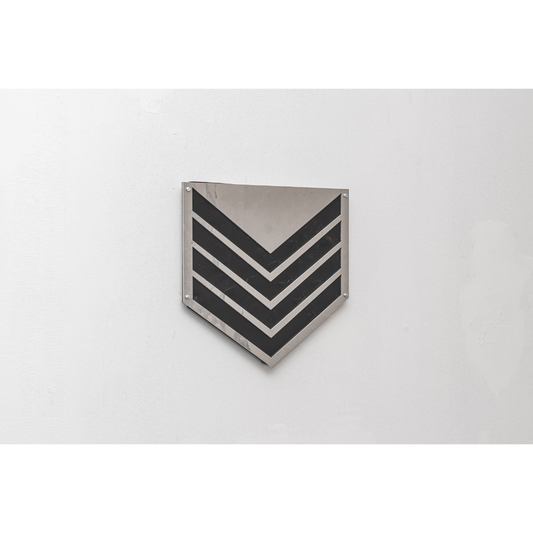
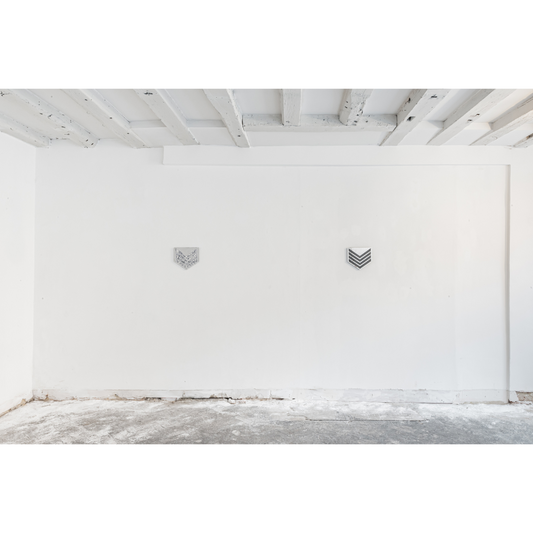 SoldTheo Papandreopoulos
SoldTheo Papandreopoulos
 Echo’s Bones gallery exhibition view from outside Lion & Lamb Art Space
Echo’s Bones gallery exhibition view from outside Lion & Lamb Art Space







 Original Italian theatrical release poster of Pasolini’s adaptation of Sade’s The 120 Days of Sodom; source:
Original Italian theatrical release poster of Pasolini’s adaptation of Sade’s The 120 Days of Sodom; source: 

 Interior, Sunlight on the Floor, 1906, Vilhelm Hammershøi.
Interior, Sunlight on the Floor, 1906, Vilhelm Hammershøi. 
 Exhibition prop
Exhibition prop
